|
< Earlier Kibitzing · PAGE 2 OF 2 ·
Later Kibitzing> |
| Aug-09-04 | | Saruman: Gypsy; I guess you meant 31.-bxb3 etc, anyway perhaps you missed 33.Bc7! instead of a5. |
|
| Aug-09-04 | | Gypsy: Actually, I just think immediate 34.a5 is stronger still <Saruman>. Black can not stop that pawn without heavy casualties. The d8 rook is no match for the d6 bishop -- 35.Bc7 is still one of the threats and if 34...Nb8 then 35.a6 decides the game. |
|
| Aug-09-04 | | Saruman: You have a point there perhaps I hadnt analyzed the position that deep :-), ill have to check out later which is the best. |
|
| Aug-09-04 | | Gypsy: Btw, welcome to the site <Saruman>! |
|
| Nov-23-04 | | Whitehat1963: Wow! What a different looking opening for Capablanca. |
|
| Nov-23-04 | | kostich in time: Capablanca was in excellent form at Buenos Aires..played several nice games,though almost exclusively against players of the seond rank. If Alekhine had escaped to America, a Capablanca-Alekhine rematch would almost certainly have taken place. Instead, Alekhine spent the war winning Nazi tournaments and writing such "gems" as "The Aryan concept of attack"( and privately writing careful analysis of the Kashdan-Reshevsky match, in which he was quite complimentary to both non-Aryans) |
|
Oct-21-05
 | | Mateo: 8... Be7?! is not very good, as it allows Capablanca to destroy black's pawn structure on the queenside. Christiansen and Kotov, for instance, played here the more logical 8... Bd7, so that if 9. Nc6 Bc6. |
|
Oct-21-05
 | | Mateo: 10.e4 is good too. White won some games with this natural move. |
|
Oct-21-05
 | | Mateo: If 12. e4 (instead of 12. Na3) 12... Nb6 13. Rd8 Na4 14. Rd7 is unclear. For instance, 14... Rfd8 15. Re7 Rd1 16. Bf1 Rc1 (16... Ba6 17. Nd2) 17. Rb7 Nc5 18. Rb4 Rd8 19. Rc4 Rdd1 20. Rc1 Rc1. It is not sure at all that white can free his rook and knight. |
|
Oct-21-05
 | | Mateo: 22... Ba6? loses a pawn. 22... Be2 was the only move. But after 23. Rd2 Bh5 Capablanca has much a better ending. |
|
| Nov-24-05 | | gmgomes: This was Capablanca´s last official game. |
|
| Jun-06-06 | | Aspirador: After 31... Bxb3, 32. a5 there is still 32... Bd5!
I would prefer 32. Bb7 first. |
|
| Dec-28-08 | | Ulhumbrus: 21 b3 begins to force Black's QB to go to a6 and block Black's a pawn, whereupon after Bc5 the a7 pawn cannot advance so as to evade the attack. |
|
| Dec-28-08 | | visayanbraindoctor: <gmgomes: This was Capablanca´s last official game.> Finally I have been able to replay Capa's last official game! A smooth Catalan performance against an inaccurately-playing Trompovsky. |
|
| Jan-14-09 | | notyetagm: Capablanca vs Trompowsky, 1939 12 ?

click for larger view(VAR) 12 e2-e4 <pin>

click for larger view<Mateo: If 12. e4 (instead of 12. Na3) 12... Nb6 13. Rd8 Na4 14. Rd7 is unclear. For instance, 14... Rfd8 15. Re7 Rd1 16. Bf1 Rc1 (16... Ba6 17. Nd2) 17. Rb7 Nc5 18. Rb4 Rd8 19. Rc4 Rdd1 20. Rc1 Rc1. It is not sure at all that white can free his rook and knight.> (VAR) 14 ♖d8-d7 <fork>
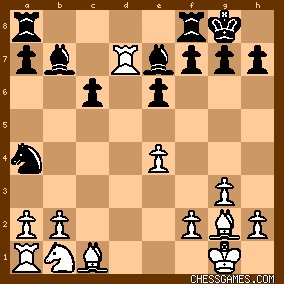
click for larger viewHmmm. http://www.truechess.com/web/oversi... calls it one of <Capablanca's Oversights>. < 12.Na3? [A less sophisticated player would have played 12.e4! and won material. Both players must have thought that 12...Nb6 keeps material even, but after 13.Rxd8 Nxa4 comes 14.Rd7! and White wins one of the bishops]> Who is correct? What does <RYBKA 3> say? |
|
| Jan-15-09 | | nimh: Charles Sullivan is right. R3 proposes the following freeing maneuver: (1.47): 21.Kg2 Nxe4 22.Bd3 Nc5[] 23.Be2[] Na4 24.Kf3 Nxb2 25.Ke3 Na4 26.Kd2 Rh1 27.h4 Nb6 28.Bd1 
click for larger view |
|
| Jan-23-09 | | RandomVisitor: 1: Jose Raul Capablanca - Trompowsky, Buenos Aires ol (Men) f-A 1939

click for larger viewAnalysis by Rybka 3 : <20-ply> 1.  (1.72): 12...Nb6 13.Rxd8 Nxa4 14.Rd7 Rfd8 15.Rxe7 Rd1+ 16.Bf1 Rxc1 17.Rxb7 Nc5 18.Rc7 Na6 19.Rd7 Nb4 20.a4 Nc2 21.Ra3 Rxb1 22.Rf3 Rf8 23.Rc3 Ne1 24.f4 g5 25.fxg5 f5 26.e5 f4 27.g4 Rb8 (1.72): 12...Nb6 13.Rxd8 Nxa4 14.Rd7 Rfd8 15.Rxe7 Rd1+ 16.Bf1 Rxc1 17.Rxb7 Nc5 18.Rc7 Na6 19.Rd7 Nb4 20.a4 Nc2 21.Ra3 Rxb1 22.Rf3 Rf8 23.Rc3 Ne1 24.f4 g5 25.fxg5 f5 26.e5 f4 27.g4 Rb8 2.  (2.07): 12...Qb6 13.exd5 cxd5 14.Qb3 Qxb3 15.axb3 Bc6 16.Bf4 Bf6 17.Nc3 g5 18.Bd2 a5 19.Rac1 Rfc8 20.Na4 Bxa4 21.Rxc8+ Rxc8 22.bxa4 Bxb2 23.Rb1 Bd4 24.Bxa5 Ra8 25.Rb5 (2.07): 12...Qb6 13.exd5 cxd5 14.Qb3 Qxb3 15.axb3 Bc6 16.Bf4 Bf6 17.Nc3 g5 18.Bd2 a5 19.Rac1 Rfc8 20.Na4 Bxa4 21.Rxc8+ Rxc8 22.bxa4 Bxb2 23.Rb1 Bd4 24.Bxa5 Ra8 25.Rb5 3.  (2.09): 12...Bf6 13.exd5 cxd5 14.Nc3 Qb6 15.Qb5 Qxb5 16.Nxb5 Bc6 17.Nd4 Bd7 18.b3 a5 19.f4 Rfc8 20.Bf1 Rc7 21.Rb1 Rac8 22.Bb2 h6 23.Ba6 (2.09): 12...Bf6 13.exd5 cxd5 14.Nc3 Qb6 15.Qb5 Qxb5 16.Nxb5 Bc6 17.Nd4 Bd7 18.b3 a5 19.f4 Rfc8 20.Bf1 Rc7 21.Rb1 Rac8 22.Bb2 h6 23.Ba6 |
|
| Jan-24-09 | | AnalyzeThis: This game was over long before black realized it was. |
|
| Jan-24-09 | | M.D. Wilson: Octavio Figueira Trompowsky de Almeida. What a name. |
|
| Feb-23-09 | | WhiteRook48: maybe Capablanca also wanted to show he was passive when he played 12 Na3 |
|
| Feb-26-11 | | Ulhumbrus: After 23 Bc5 Black's Rook finds suddenly itself overworked. It is unable to defend the a7 pawn and defend the back rank as well. |
|
| Feb-26-21 | | Gaito: Capablanca usually liked to steer clear from unnecessary complications, even if sometimes the complications might be favorable to him. That was a good approach to save time and energy. He always sought clarity and simplicity. Take a look at the following diagram:

click for larger view
The move 12.e4 begs to be played, but presumably Capa rejected it on account of the unnecessary complications that would arise after that move. For example: 12.e4 Nb6 13.Rxd8 Nxa4 14.Rd7 Rfd8 15.Rxe7 Rd1+ 16.Bf1 Rxc1 17.Rxb7 Nc5 18.Rb4 (or else 18.Rc7 Nxe4) Rd8 19.Rc4 Rdd1 (see diagram below):
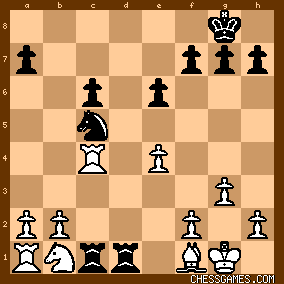
click for larger view
This is a very complicated position where White has a piece to the good but his Q-side pieces can't be developed yet, for instance: 20.Rxc1 Rxc1 21.Kg2 Nxe4 (diagram):
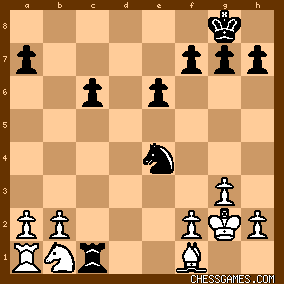
click for larger view
I am sure that Capablanca just wouldn't have liked to play White in this position, even if he has an extra piece for a pawn. |
|
| Feb-26-21 | | Gaito: Where did Black go wrong in the opening? A critical moment was after 16.Bf4 (see diagram below):

click for larger view
Black played 16...Rac8?, and that move turned out to be the decisive mistake. He should have played 16...c5! with a good game (maybe equality). For example: 16...c5! 17.b3 Qa6 18.Bc7 Rd4 (see diagram below):
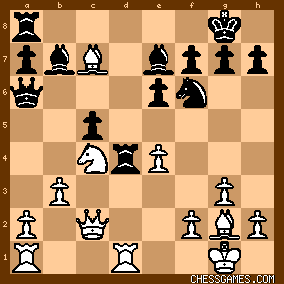
click for larger view
Black has a playable middle-game, and nothing to fear. |
|
| Feb-26-21 | | Gaito: The following position deserves also a brief commentary:

click for larger view
A few years ago I was giving a (chess) class to a group of some 20 students, most of them kids (8 to 14 years old), and I happened to show them this particular game (I can't recall for what reason), and I remember that one of my young students suggested that White might win more quickly in this position with the move 18.Bf1, instead of 18.Bxe7 which was the move chosen by Capablanca. Since we did not have an engine at the time, I told my student that maybe he was right, and 18.Bf1 might perhaps be a stronger alternative. But now I do have some chess engines, and the conclusion is that the move 18.Bf1 is good, but Capablanca's move was possibly better. A sample variation: 18.Bf1!? Qb7 19.Bxe7 Qxe7 20.e5 Ne8 21.Nd6 Nxd6 22.Bxa6 Nb7 23.Rxd8+ Rxd8 24.Rc1 c5 25.b4! Rd5 (25...cxb4 26.Qc6! is too strong) 26.Qa4 (see diagram below):
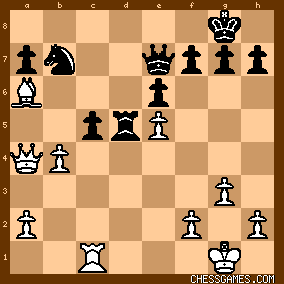
click for larger view
White has a strong pressure on the Q-side, for example: 26...g6 27.Qb5 Qg5 28.f4, etc. Looks like White has a winning advantage in this position too. |
|
Sep-08-21
 | | GrahamClayton: A typical example of Capablanca's positional style. He isolates Black's c-pawn (9. Nc6 bc6) and then builds up pressure on it. Trompowsky is forced to make positional concessions to defend it, and eventually ends up in a lost position. |
|
 |
|
< Earlier Kibitzing · PAGE 2 OF 2 ·
Later Kibitzing> |





